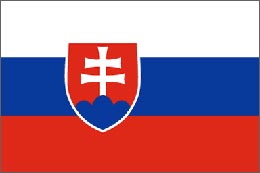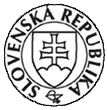Slovakia Facts and General Information
| Official name: | Slovak Republic (orig. Slovenská republika) (SR) |
|---|---|
| Establishment date: | 1st January 1993 |
| Capital city: | Bratislava |
| Establishment: | Republic |
| Political system: | Parliamentary Democracy (150-seat unicameral, delegates are elected for 4-year term) |
| President: | Ivan Gašparovič, elected for 5-year term |
| Prime Minister | Robert Fico, political party SMER - sociálna demokracia |
| Location: | Central Europe |
| Language: | Slovak |
| Currency: | EURO (since 1st Jan 2009) |
| Population: | 5 447 502 inhabitants |
| Area: | 49 035 sq km |
| Time Zone: | CET (Central European time) GMT + 1 |
| Country Calling Code: | +421 |
| Country Code: | SK |
Membership in international organisations: Slovakia is a member state of the European Union since 1 May 2004, NATO since 29 March 2004, a member of the United Nations since 1993 and Schengen Agreement since 21 December 2007.
Bordering Countries: The bordering countries are Czech Republic, Poland, Ukraine, Hungary and Austria.
Slovakia lies in Central Europe surrounded by five countries: Czech Republic, Poland, Ukraine, Hungary and Austria. Its total area of 49,035 sq km (18,932 sq mi) and population of 5,389,180 do not rank Slovakia among large countries. Population density is 189 persons per sq km. Slovak population distribution is quite uneven. The most densely populated are large cities and the Danubian Lowland. Less people live in East Slovak Basin and Záhorská Lowland. Cooler northern mountainous regions and east of the country are characteristic by very low population density. It is mainly due to the lack of fertile lands.
Most people living in Slovakia have Slovak nationality. They represent 85.5% of the whole population. Than there are about 520,000 citizens with Hungarian nationality. They represent 9.7% of the Slovak population. Mostly they live in southern regions close to Hungarian borders: Komárno, Dunajská Streda, Nové Zámky, Galanta, Šaľa, Rimavská Sobota, Rožňava and Trebišov districts. Actually, they prevail over the citizens with Slovak nationality in Komárno and Dunajská Streda districts. The third biggest nationality is Romani people with 90,000 citizens that represent about 1.7% of our population. Slovakia is also home to other nationalities: Czechs (0.8%), Ruthenians and Ukrainians living mostly in eastern Slovak regions.
Slovakia Flag |
Slovakia State Symbol |
Slovakia Seal |
 |
 |
 |
Slovak Anthem
| Nad Tatrou sa blýska, hromy divo bijú, Zastavme ich, bratia, veď sa ony stratia, Slováci ožijú. To Slovensko naše posiaľ tvrdo spalo, ale blesky hromu vzbudzujú ho k tomu, aby sa prebralo. |
Above Tatra bolts of lightning, thunderstorm pounds wildly. Our Slovakia was in deep sleep until now. |
Official Language in Slovakia
The official language in Slovakia is Slovak language and is spoken by majority of people. As 10% of inhabitants are of Hungarian nationality there are areas in Slovakia where people speak mostly Hungarian. The regions include especially South parts around Komárno, Dunajská Streda, Šala, Štúrovo and Nové Zámky.
Primary education language in Slovakia is Slovak. Students learn foreign languages especially English and German, but also Spanish, French or Italian. Till 1989 the first foreign language in Slovak schools was Russian language and therefore older people are usually fluent in Russian but have problems communicating in other foreign languages. Slovak language belongs to the group of Slavic languages and similar languages include Croatian, Polish, Czech, Ukraine and Russian languages. If you wish to learn more about Slovak language and learn basic Slovak vocabulary, please visit Slovak language pages and basic Slovak vocabulary.
Slovak Currency
Since 1 Janury 2009 the official currency in Slovakia is Euro
As Slovakia is a part of European Union accepted EURO currency in January 2009. In every shopping centre and supermarket you can find ATMs and exchange office or bank. Credit cards and debut cards are widely used in most shops in Slovakia including Visa, Maestro or Master card.
Time zone
Slovakia is lies in the Central European Time Zone (CET) which is 1 hour ahead of the Coordinated Universal Time (UTC) with summer time 2 hours ahead of UTC. Time changes into Summer time in April and in October it changes back to CET or Winter time.
Electricity
In Slovakia, voltage is 220V/50Hz.
Electric sockets are of Type E of two pin wih earth connector.
Plugs: Type E of two pin wih earth connector. Widely spread are also or tyep C plugs of two pin connectors.

Drinking water
In all parts of Slovakia there is drinking water. Water coming from the tabs in households, restaurants or hotels is drinking and can be used for cooking as well as for drinking. In public places, water is usually signed whether drinking water (pitná voda) or non-drinking water (úžitková voda) intended for washing your hands only.
Public Holidays in Slovakia
| 1 January |
Day of the Establishment of the Slovak Republic |
|---|---|
| 6 January | Epiphany (The Three Magi and Christmas Day of Orthododox Christians) |
| March, April | Good Friday |
| March, April | Easter Monday |
| 1 May | Labour Day |
| 8 May |
Day of victory over fascism |
| 5 July |
St. Cyril and Methodius Day |
| 29 August | Slovak National Uprising anniversary |
| 1 September |
Day of the Constitution of the Slovak Republic |
| 15 September |
Day of Our Lady of Sorrows, patron saint of Slovakia |
| 1 November | All Saints’ Day |
| 17 November |
Struggle for Freedom and Democracy Day |
| 24 December | Christmas Eve |
| 25 December | Christmas Day |
| 26 December | St. Stephen's Day |



